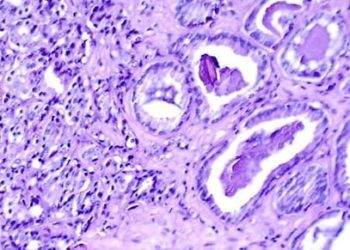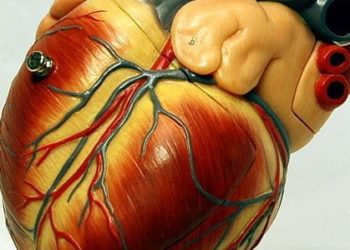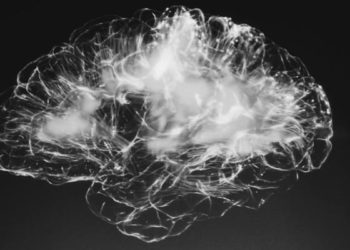2 Minute Medicine Rewind April 1, 2024
Sarcopenia and Sarcopenic Obesity and Mortality Among Older People
1. In this secondary analysis of the Rotterdam study, older adults with sarcopenia and sarcopenic obesity (SO) were at significantly higher risk for all-cause mortality than their non-SO counterparts.
Evidence Rating Level: 2 (Good)
Sarcopenia, or low skeletal muscle mass and strength, is a phenotype of age-related body composition (BC) changes. Sarcopenic obesity (SO) combines the presence of sarcopenia with a large amount of adipose tissue. Although both of these phenotypes alone lead to increased morbidity and mortality, particularly in older adults, the combination of sarcopenia and obesity is thought to amplify these negative health effects. Data was analyzed from individuals recruited to the prospective longitudinal cohort Rotterdam Study. The current study defines obesity as a body mass index (BMI; weight in kilograms divided by height in metres squared) of ≥ 27, as previous studies have established this value as a predictor of fat percentage in older people. Sarcopenia was assessed via handgrip strength (cutoffs 27 kg for men and 16 kg for women) and a low appendicular skeletal muscle mass index (ASMI) measured by a dual-energy x-ray absorptiometry (DXA) scan using a total body-beam densitometer. A total of 5888 participants had full data available on SO from the Rotterdam Study (56.8% female; mean [SD] age 69.5 [9.1] years, mean [SD] BMI 27.5 [4.3]), with median follow-up of 9.9 years. Approximately 25% of participants had deceased over the course of the study. The prevalence of probable or confirmed sarcopenia was 11.1% and 2.2%, respectively, whereas the presence of SO was detected in 5.8% of participants. All-cause mortality was significantly increased in individuals with probable sarcopenia (HR 1.29 (95% CI, 1.14-1.47)) and confirmed sarcopenia (HR 1.93 (95% CI, 1.53-2.43)), and there was a significant interaction between sarcopenia and BMI on all-cause mortality (HR, 1.94; 95% CI, 1.60-2.33 for SO plus 1 altered component of body composition; HR 2.84; 95% CI, 1.97-4.11 for SO plus 2 altered components of body composition). This large population-based study with extensive follow-up facilitated the assessment of muscle mass and adipose tissue changes in older individuals. Future studies could assess for medical morbidity in addition to all-cause mortality in individuals with SO, and studies with a less homogeneous study population (98% European ancestry in the Rotterdam Study) could improve generalizability of results. However, the results of the current study emphasize the importance of both muscle mass/function as well as adiposity in the measurement of health in older individuals.
1. Patients randomized to receive the paravertebral block (PVB) and erector spinae plane block (ESPB) had significantly more effective prevention and minimization of the impacts of post-herpetic neuralgia (PHN) in the acute period post-Herpes Zoster infection.
2. Patients randomized to receive PVB or ESPB additionally required less oral rescue analgesics and reported significantly higher quality of life at 15, 30, and 60 days post-block compared to controls.
Evidence Rating Level: 1 (Excellent)
Herpes Zoster (HZ, or shingles) is a reactivation of the Varicella Zoster virus, and a painful dermatomal rash is usually a defining acute feature of the condition. This zoster-related pain (ZP) can be debilitating for patients, and unfortunately, it may remain or continue to intensify after resolution of infection. This is particularly true in cases where initial pain experienced by the patient is more intense, with post-herpetic neuralgia (PHN) affecting between 5-50% of patients. Initial pain control should thus be a mainstay of treatment in the prevention of PHN, and two novel interfascial nerve blocks, the Paravertebral Block (PVB) and Erector Spinae Plane Block (ESPB), have been observed in case reports and observational studies as potential modulators. This single-blind, parallel arm, prospective randomized trial placed 60 participants either in the control, PVB, or ESPB group (n = 20 in each group) and followed up with patients 15, 30, and 60 days post-block. There was a significant decrease in pain intensity based on Numerical Rating Scores (NRS) in both groups receiving nerve blocks at 15, 30, and 60 days post-block (p = 0.003) when compared to controls. Rates of allodynia were also significantly lower in the groups receiving nerve blocks by 60 day follow-up (p = .04). Patients who received the block also reported a decreased need for oral rescue analgesics, with control patients reporting twice as many days requiring analgesia per week compared to those who received blocks. Improved quality-of-life was observed in both groups receiving blocks compared to the control group (p < .05) via the World Health Organization’s (WHO) quality of life (WHOQOL) scale. Finally, the overall incidence of PHN was significantly higher in the control group compared to both the ESPB and PVB groups (80%, 45% and 40%, respectively; p = .022). Overall, the results of this study demonstrate promise in the prevention and minimization of this debilitating pain, while demonstrating no significant adverse effects in patients receiving the blocks. Limitations of the current study include sample size and a lack of double-blinding, indicating the need for further research on this topic with longer observation periods. However, results indicate the potential for an efficacious, safe, and practical treatment for the early phases of HZ reinfection.
Outcomes After Initiation of Medications for Alcohol Use Disorder at Hospital Discharge
1. This retrospective study found that the use of medications for alcohol use disorder (MAUD) at discharge from hospital significantly reduced 30-day all-cause mortality, 30-day return to hospital for any reason, and improved rates of primary care and mental health follow-up post-discharge.
Evidence Rating Level: 2 (Good)
Alcohol use disorder (AUD) affects 29 million adults in the United States and is a leading cause of preventable mortality. Current Food and Drug Administration (FDA) guidelines recommend both behavioural and pharmacologic interventions for AUD, often referred to as medications for AUD (MAUD). These include naltrexone, acamprosate, and disulfiram, but despite being included in the guidelines, they are grossly underprescribed. These medications make use of differing mechanisms to reduce return to drinking or heavy drinking, and the literature on outcomes associated with MAUD initiation at hospital discharge is scant. Thus, the current retrospective cohort study emulated a randomized clinical trial to investigate the impact of initiating MAUD at hospital discharge on 30-day clinical outcomes among patients hospitalized for alcohol-related reasons. In total, 9834 alcohol-related hospitalizations (median [IQR] age, 54 [46-62] years; 32.6% female) by 6794 unique individuals were included. Only 2.0% of hospitalizations included a MAUD prescription at discharge. However, MAUD initiation was associated with a 42% relative and 18% absolute reduction in 30-day all-cause mortality or a return to hospital compared to those who did not receive MAUD (IRR, 0.58 [95% CI, 0.45 to 0.76]; ARD, −0.18 [95% CI, −0.26 to −0.11]). Secondary outcomes, including a return for any reason (IRR, 0.56 [95% CI, 0.43 to 0.73]; ARD, −0.19 [95% CI, −0.27 to −0.12]) and alcohol-related diagnoses (IRR, 0.49 [95% CI, 0.34 to 0.71]; ARD, −0.15 [95% CI, −0.22 to −0.09) were significantly reduced in the MAUD group. Finally, follow up with primary care or mental health services was also associated with MAUD initiation at discharge (IRR, 1.22 [95% CI, 1.04 to 1.44]; ARD, 0.10 [95% CI, 0.02 to 0.18]). Overall, this cohort study found that discharge MAUD initiation decreased 30-day mortality, 30-day all-cause return to hospital, and was correlated to increased primary or mental health care follow-up in patients struggling with AUD. The inherent limitations of an observational study design may decrease its generalizability, but randomized trials should be conducted to elucidate the findings of the current study. Discharge MAUD may present a feasible method by which to increase primary and mental health follow up and temporize rates of 30-day mortality and a return to hospital in individuals struggling with AUD.
Associations between maternal pre-pregnancy BMI and infant striatal mean diffusivity
1. Tissue density in the left caudate nucleus was significantly decreased in infants whose mothers had elevated pre-pregnancy body-mass indexes (BMI).
Evidence Rating Level: 2 (Good)
Parental obesity, particularly maternal obesity prior to pregnancy, has been identified as a risk factor for offspring obesity by means of both heritable and environmental influences. The mechanisms by which this is thought to take place are complex and varied, but alterations in functioning of neurotransmitter signalling are believed to contribute. This is particularly true of the caudate and lentiform nuclei. The striatum is implicated in reward pathways and hedonic eating, and preclinical studies have observed structural changes and differences in neural processing of both adolescents and adults who are overweight or obese. Diffusion tensor imaging (DTI) allows for the study of white matter and subcortical structures, and mean diffusivity (MD) is a measure derived from DTI images best used for assessing grey matter structures. Decreased MD is a marker of high tissue density, and the current study hypothesized that pre-pregnancy BMI was positively associated with infant striatal MD. Data collected on infants between 1 to 6 weeks from birth from the Finnbrain Birth Cohort Study was used. These infants were born to singleton pregnancies after gestational week 35 and did not demonstrate any perinatal complications. After all exclusion criteria were met, there were 116 mother-infant dyads whose MRI, obstetric data, and maternal demographics were collected. Sixteen of these dyads had mothers with gestational diabetes mellitus (GDM). The six striatal brain regions of interest included the right and left putamen, right and left globus pallidus, and right and left caudate nuclei. There were no significant sex differences in mean MD values in these regions, but there was a positive association between pre-pregnancy BMI and mean MD only in the left caudate nucleus, regardless of maternal GDM status (p = .006, R2partial = .07). These results correlate to previous studies which observed increased caudate nucleus activation in response to high sugar content food in adolescents with high-BMI parents. Limitations to this study include the small number of dyads which included mothers with GDM, and a lack of control for paternal BMI values. Future studies should also control for other exposures in utero that may have contributed to these findings, and longitudinal studies should be implemented to assess for a programming effect. However, these current findings suggest a positive association between maternal pre-pregnancy BMI and decreased tissue density in the left caudate nucleus, which could suggest a maturation effect.
Low vitamin D levels accelerates muscle mass loss in patients with chronic liver disease
1. In a cohort of patients with chronic liver disease, low vitamin D levels were significantly and independently associated with skeletal muscle mass loss within one year.
2. Nonalcoholic fatty liver disease (NAFLD) bore the strongest associations to low 25-hydroxyvitamin D levels and muscle loss.
Evidence Rating Level: 2 (Good)
Sarcopenia, the loss of skeletal muscle mass and strength, is a common sequelae of disease in patients with cirrhosis. The presence of sarcopenia (or even the general loss of muscle mass) also tends to worsen the prognosis of these patients. The loss of lean mass in individuals without cirrhosis is 1% per year (ages 30 to 70) and 1.5% annually thereafter, versus a 2.2% annual rate of skeletal muscle mass loss in individuals with cirrhosis which worsens with more severe Child-Pugh class scores. Branched-chain amino acid (BCAA) and/or vitamin D supplementation and exercise are preventative lifestyle measures, and many longitudinal studies of older adults have revealed the association between low vitamin D levels and muscle mass loss, with deficiency being associated with atrophy of fast-twitch muscle fibres and fatty infiltration of skeletal muscle. The current retrospective study analyzed data from 166 individuals (59.0% female, median [IQR] age 68 [58-74] years) to investigate several factors associated with muscle loss at one-year follow-up for patients with chronic liver disease. Etiologies included chronic hepatitis C viral infection (HCV), nonalcoholic fatty liver disease (NAFLD), chronic hepatitis B viral infection (HBV), alcoholic-related liver disease (ALD), primary biliary cholangitis (PBC), autoimmune hepatitis (AIH), and others. Skeletal muscle mass index (SMI) at one-year follow-up was not significantly different (p = .07), but loss of muscle mass was found in 31% of patients. The only variable that significantly differed between those that experienced muscle loss and those that did not was serum 25-hydroxyvitamin D levels (p = .0025). It appears that muscle loss was most prominent in patients with NAFLD (48.7%; p < .05), followed by ALD (28.6%), HBV/HCV (28.4%), and PBC/AIH (18.5%). The cutoff of ≥12.7 ng/mL for serum 25-hydroxyvitamin D levels was a significant predictor of muscle mass loss (p < .0001), complicated cirrhosis (p < .01), lower hemoglobin (p < .01), platelet counts (p < .01), prothrombin time (p < .01), and total cholesterol (p < .01). Gamma-glutamyl transpeptidase (GGT) levels were significantly lower in patients with 25-hydroxyvitamin D levels above the cutoff (p < .01). Levels ≥12.7 ng/mL were most strongly associated with muscle loss in patients with NAFLD. The results of this study indicate that low baseline 25-hydroxyvitamin D levels (<12.7 ng/mL) were independently associated with muscle loss, suggesting that this sequelae of chronic liver disease may be complicated by low vitamin D levels, with opportunities to attenuate this risk through early supplementation. Further longitudinal studies with larger cohorts will be required to confirm the generalizability of these results.
Image: PD
©2024 2 Minute Medicine, Inc. All rights reserved. No works may be reproduced without expressed written consent from 2 Minute Medicine, Inc. Inquire about licensing here. No article should be construed as medical advice and is not intended as such by the authors or by 2 Minute Medicine, Inc.







